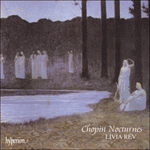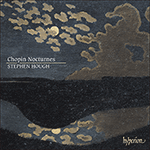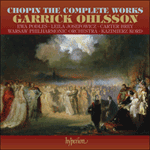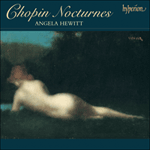The third Nocturne of this group, in G minor, is not a typical Nocturne at all. In fact, it begins as a mazurka and ends as a chorale. There is no going back to the opening material once it is presented. This is one Nocturne where I think Chopin’s metronome mark is particularly revealing: too slow a tempo makes it impossibly sluggish. It is still possible for it to sound languishing, as Chopin demands, and for the rubato to be used where needed. His harmonic language is rich and expressive, taking us as far away as F sharp major before reaching a chromatic bridge into the religioso section. This is in D minor/F major and in strict four-part writing. A brief return to mazurka rhythm leads us to the close in G major. Chopin originally subtitled it ‘After a performance of Hamlet’, but then removed it, saying ‘Let them guess themselves’. I doubt that anybody would have done so.
from notes by Angela Hewitt © 2004
Le troisième nocturne de cet opus, en sol mineur, n’a de nocturne que le nom, puisqu’il commence comme une mazurka et s’achève comme un choral. On ne revient pas au matériau d’ouverture une fois qu’il a été présenté. Voilà un nocturne où, à mon sens, l’indication métronomique de Chopin est particulièrement révélatrice: un tempo trop lent le rend insupportablement apathique. Il peut tout de même sonner languissant, comme l’exige Chopin, et le rubato demeure possible là où la partition le demande. Son langage harmonique riche et expressif nous entraîne jusqu’à fa dièse majeur avant d’atteindre un pont chromatique pour la section religioso, en ré mineur/fa majeur, dans une écriture stricte à quatre parties. Un bref retour au rythme de mazurka nous amène à la conclusion en sol majeur. Chopin, qui donna d’abord à cette pièce le sous-titre «Après une représentation de Hamlet», le supprima ensuite en disant: «Laissons-les deviner tout seuls». Je doute que quiconque l’eût fait.
extrait des notes rédigées par Angela Hewitt © 2004
Français: Hypérion
Das dritte Nocturne op. 15 steht in g-Moll und ist überhaupt kein typisches Nocturne. Tatsächlich fängt es wie eine Mazurka an und endet als Choral. Nachdem das Anfangsmaterial vorgestellt wurde, wird darauf nicht mehr Bezug genommen. Meiner Ansicht nach ist in diesem Nocturne Chopins Metronomangabe besonders aufschlussreich: ein zu langsames Tempo macht es viel zu schwerfällig. Es kann immer noch schmachtend klingen, wie Chopin verlangt, und das Rubato kann eingesetzt werden, wo nötig. Seine harmonische Sprache ist hier besonders reichhaltig und ausdrucksvoll und führt uns bis nach Fis-Dur, bevor wir zu einer chromatischen Brücke kommen, die in den „religioso“-Teil hinüberleitet. Dieser steht in d-Moll beziehungsweise F-Dur und ist streng vierstimmig gehalten. Eine kurze Rückkehr zu dem Mazurka-Rhythmus führt uns ins nahe G-Dur. Chopin versah es ursprünglich mit dem Untertitel „Nach einer Aufführung des Hamlet“, überlegte es sich dann aber anders und entfernte den Untertitel mit der Begründung: „Sollen sie es selbst erraten“. Ich wage zu bezweifeln, dass das irgendjemand getan haben wird.
aus dem Begleittext von Angela Hewitt © 2004
Deutsch: Viola Scheffel


 Chopin: Nocturnes
Chopin: Nocturnes Chopin: Nocturnes
Chopin: Nocturnes Chopin: The Complete Works
Chopin: The Complete Works Chopin: Nocturnes & Impromptus
Chopin: Nocturnes & Impromptus
